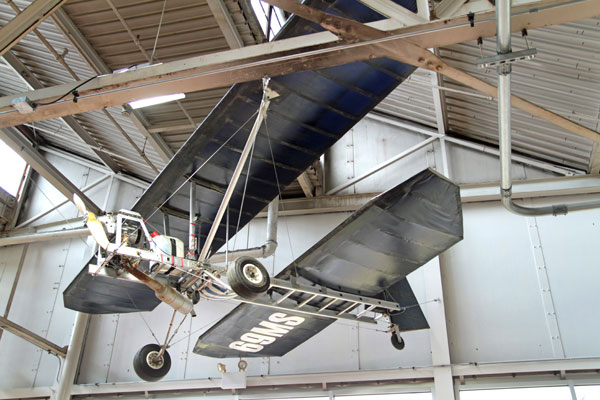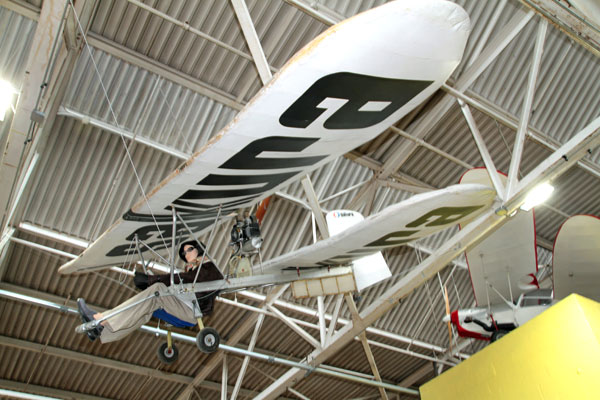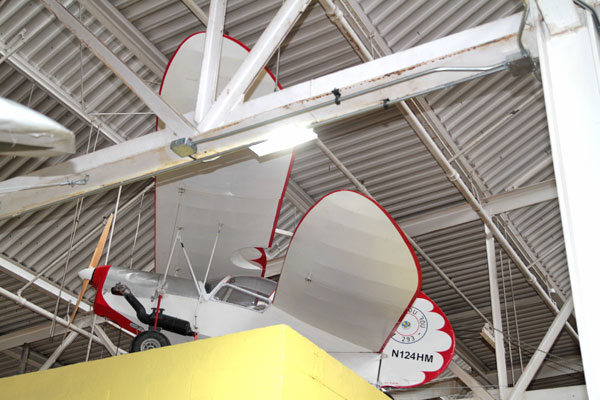Dalby Pouchel “Ladder Flea”
In 1997, inspired by the design of Henri Mignet’s Flying Fleas and by Mignet’s philosophy of making flying accessible to the masses, French engineer Daniel Dalby conceived an idea for an inexpensive, homebuilt aircraft utilizing inherently light and strong aluminum ladders. The example seen overhead is actually made out of three ladders; one makes up the clearly visible fuselage, and the other two comprise the inner framework of the tandem wings. The Pouchels (“ladder fleas” in English) use a control system similar to the Flying Fleas, with a pivoting front wing and rudder, both operated by the control column via control rods, and no foot pedals. Starting in 2002, the ladder manufacturer refused to sell its products as a framework for airplanes, citing liability and insurance issues. Dalby then redesigned the aircraft to replace the ladders with rectangular-section aluminum tubes, and the Pouchel II was born. It was subsequently replaced by an even lighter version, the Pouchel Light. Plans for this plane are readily available today through the APEV, or Association pour la Promotion des Echelles Volantes (English: Association for the Promotion of Flying Ladders)
Specifications:
Manufacturer: Homebuilt
Country of Origin: France
Designer: Daniel Dalby
Engine: Rotax 337 two-cylinder, two-stroke, air-cooled, 35hp
Empty Weight: Design – 220 lbs.
Gross Takeoff Weight: 551 lbs.
Cruise Speed: 56 mph
Wingspan: 19 ft. 8 in.
Years of Production: 1999 – 2002
Number Produced: Over 120 plans have been sold to members of APE.
1979 “Butterfly”
Designed in 1979 by two Belgians, Raymond Mossoux and Guy Francios, the Butterfly was initially just a glider. Thanks to its low weight and its high lifting surface, it could take off by being towed by a car until it reached take off speed, or, more simply, just by its pilot leaping from a slope into the wind.
Soon after, a young engineer by the name of Jean-Claude Vinois, installed on his Butterfly a JVC engine, which developed 20hp at 8,000 rpm with a weight of only 16.5 lbs! This ultralight airplane was considered during its time to be the lightest aircraft in the world, with an empty weight of only 145 lbs! Butterfly kits were offered to amateur builders. Assembly time was about 10 days, a record time. Only a few hours of training were necessary to get the Butterfly under control.
Designed according to the Flying Flea formula created by Henri Mignet, the Butterfly is a staggered wings biplane, which, as its famous ancestor refuses spinning or stalling, makes it an ideal aircraft for novice pilots. However, let there be no mistake, this valiant little aircraft has very good performance capabilities and has participated in several competitions with excellent and often outstanding results. One, for instance, was in the first London-Paris race reserved for motorized ultralights.
On September 3rd, 1983, 67 motorized ultralights took off from Biggin Hill Airport, south of London to reach Paris. A refueling stop was planned at Lydd before crossing the channel to Cape Gris-Nez in France (about 20 miles above sea level) with another stop at Le Touquet, France.
At the finish line of the race in Paris, a crowd of 50,000 onlookers had come to applaud those new pioneers on the lawn of Bagatelle (where 76 years before, Santos-Dumont had won his world record). Because of a very strong, gusty wind, only 20 participants including the Butterfly and its pilot René Thierry dared take off form Le Touquet and struggled to land as they could at Bagatelle. The Butterfly should have won the race, but the outcome was annulled due to the extreme weather conditions.
A second version of the ultralight Butterfly was built, always in kit form, by the Belgian company “Brugeoise et Nivelles”, mainly known for manufacturing railway equipment.
Altogether, about 50 kits were sold. Two restored Butterflies are currently flying in Belgium.
Specifications:
Empty weight: 143 lbs.
Max takeoff weight: 352 lbs.
Wing area: 121.8 sq. ft.
Wing loading: 2.8 lb/sp. ft
Length: 11”3”
Span: 20’ 3”
Liftoff speed: 18 mph
Cruise speed: 43 mph
Takeoff speed: 28 mph
Max speed: 75 mph
Fuel consumption: .66 US gal/hr
HM.293 “Pou Fou”, or “Crazy Flea”.
Due to a request for a light reconnaissance plane needed by the French resistance during WWII, Henri Mignet developed the HM.280. Only a prototype was completed. After the war, Mignet did publish the plans for a civilian version, the HM.290. After elongating the fuselage and tilting the firewall back, yet another redesign yielded the HM.293, built to handle a larger engine and slightly larger pilot. The HM.280-290 series also marked the beginning of the folding-wing design. Although this added weight, it satisfied Mignet’s intent for homebuilt planes to be stored in garages and to be able to be towed to the airfield. In the 1980s, Rodolphe Grunberg designed an Ultralight version of the HM.293. Several hundred versions of the Grunberg HM.293 were built, or are under construction.
Built by Yves Segonds, this HM.293 was named the “Pou Fou”, or “Crazy Flea”. Note the backwards letters the spell “Le Pou Fou” on the rudder.
Specifications:
Manufacturer: Homebuilt by Yves Segonds
Country of Origin: France
Designer: Rodolphe Grunberg after Henri Mignet
Engine: Rotax 447, two-cylinder, two-stroke, 42hp
Empty Weight: Design – 374 lbs.
Gross Takeoff Weight: 628 lbs.
Cruise Speed: 80 MPH (estimated)
Wingspan: 20 ft.
Years of Production: 2000-present
Number Produced: Hundreds of copies of HM.293



